Guillermo Cecchi
Deep Generative Sampling in the Dual Divergence Space: A Data-efficient & Interpretative Approach for Generative AI
Apr 10, 2024



Abstract:Building on the remarkable achievements in generative sampling of natural images, we propose an innovative challenge, potentially overly ambitious, which involves generating samples of entire multivariate time series that resemble images. However, the statistical challenge lies in the small sample size, sometimes consisting of a few hundred subjects. This issue is especially problematic for deep generative models that follow the conventional approach of generating samples from a canonical distribution and then decoding or denoising them to match the true data distribution. In contrast, our method is grounded in information theory and aims to implicitly characterize the distribution of images, particularly the (global and local) dependency structure between pixels. We achieve this by empirically estimating its KL-divergence in the dual form with respect to the respective marginal distribution. This enables us to perform generative sampling directly in the optimized 1-D dual divergence space. Specifically, in the dual space, training samples representing the data distribution are embedded in the form of various clusters between two end points. In theory, any sample embedded between those two end points is in-distribution w.r.t. the data distribution. Our key idea for generating novel samples of images is to interpolate between the clusters via a walk as per gradients of the dual function w.r.t. the data dimensions. In addition to the data efficiency gained from direct sampling, we propose an algorithm that offers a significant reduction in sample complexity for estimating the divergence of the data distribution with respect to the marginal distribution. We provide strong theoretical guarantees along with an extensive empirical evaluation using many real-world datasets from diverse domains, establishing the superiority of our approach w.r.t. state-of-the-art deep learning methods.
COMPASS: Computational Mapping of Patient-Therapist Alliance Strategies with Language Modeling
Feb 22, 2024Abstract:The therapeutic working alliance is a critical factor in predicting the success of psychotherapy treatment. Traditionally, working alliance assessment relies on questionnaires completed by both therapists and patients. In this paper, we present COMPASS, a novel framework to directly infer the therapeutic working alliance from the natural language used in psychotherapy sessions. Our approach utilizes advanced large language models to analyze transcripts of psychotherapy sessions and compare them with distributed representations of statements in the working alliance inventory. Analyzing a dataset of over 950 sessions covering diverse psychiatric conditions, we demonstrate the effectiveness of our method in microscopically mapping patient-therapist alignment trajectories and providing interpretability for clinical psychiatry and in identifying emerging patterns related to the condition being treated. By employing various neural topic modeling techniques in combination with generative language prompting, we analyze the topical characteristics of different psychiatric conditions and incorporate temporal modeling to capture the evolution of topics at a turn-level resolution. This combined framework enhances the understanding of therapeutic interactions, enabling timely feedback for therapists regarding conversation quality and providing interpretable insights to improve the effectiveness of psychotherapy.
Remote Inference of Cognitive Scores in ALS Patients Using a Picture Description
Sep 13, 2023
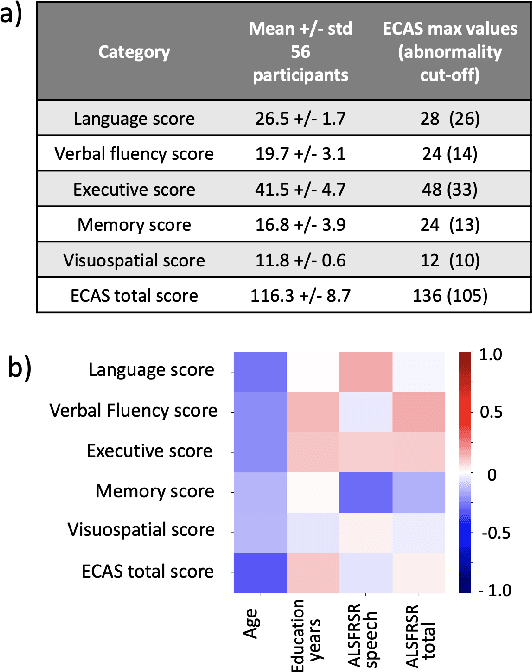
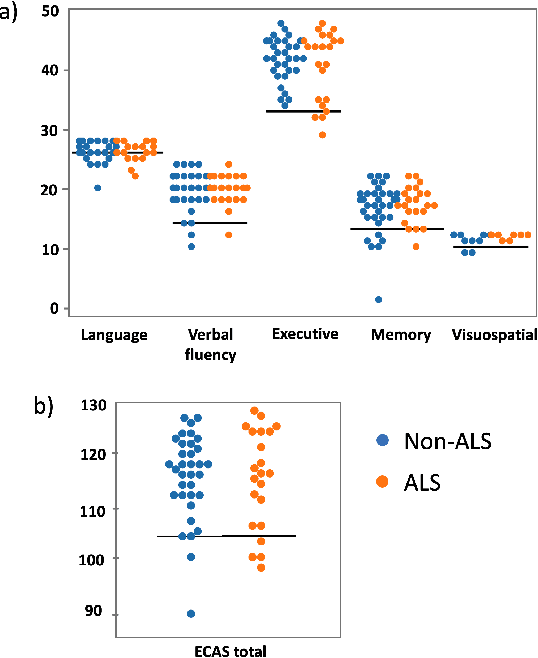
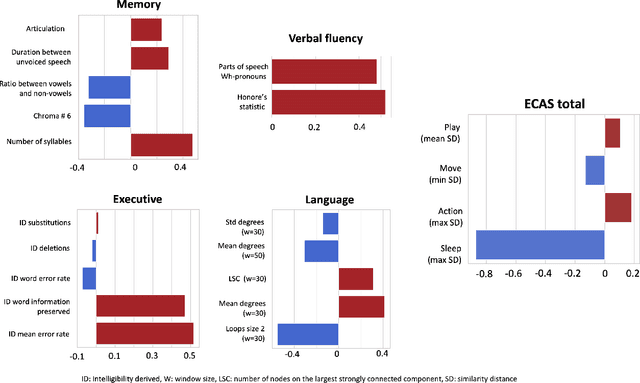
Abstract:Amyotrophic lateral sclerosis is a fatal disease that not only affects movement, speech, and breath but also cognition. Recent studies have focused on the use of language analysis techniques to detect ALS and infer scales for monitoring functional progression. In this paper, we focused on another important aspect, cognitive impairment, which affects 35-50% of the ALS population. In an effort to reach the ALS population, which frequently exhibits mobility limitations, we implemented the digital version of the Edinburgh Cognitive and Behavioral ALS Screen (ECAS) test for the first time. This test which is designed to measure cognitive impairment was remotely performed by 56 participants from the EverythingALS Speech Study. As part of the study, participants (ALS and non-ALS) were asked to describe weekly one picture from a pool of many pictures with complex scenes displayed on their computer at home. We analyze the descriptions performed within +/- 60 days from the day the ECAS test was administered and extract different types of linguistic and acoustic features. We input those features into linear regression models to infer 5 ECAS sub-scores and the total score. Speech samples from the picture description are reliable enough to predict the ECAS subs-scores, achieving statistically significant Spearman correlation values between 0.32 and 0.51 for the model's performance using 10-fold cross-validation.
GOKU-UI: Ubiquitous Inference through Attention and Multiple Shooting for Continuous-time Generative Models
Jul 11, 2023
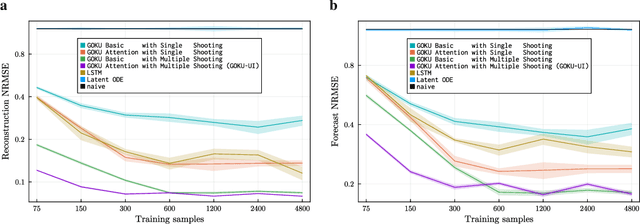
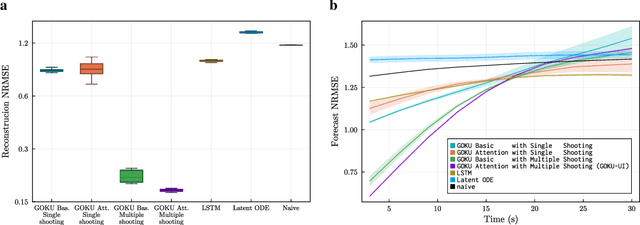

Abstract:Scientific Machine Learning (SciML) is a burgeoning field that synergistically combines domain-aware and interpretable models with agnostic machine learning techniques. In this work, we introduce GOKU-UI, an evolution of the SciML generative model GOKU-nets. The GOKU-UI broadens the original model's spectrum to incorporate other classes of differential equations, such as Stochastic Differential Equations (SDEs), and integrates a distributed, i.e. ubiquitous, inference through attention mechanisms and a novel multiple shooting training strategy in the latent space. These enhancements have led to a significant increase in its performance in both reconstruction and forecast tasks, as demonstrated by our evaluation of simulated and empirical data. Specifically, GOKU-UI outperformed all baseline models on synthetic datasets even with a training set 32-fold smaller, underscoring its remarkable data efficiency. Furthermore, when applied to empirical human brain data, while incorporating stochastic Stuart-Landau oscillators into its dynamical core, it not only surpassed state-of-the-art baseline methods in the reconstruction task, but also demonstrated better prediction of future brain activity up to 12 seconds ahead. By training GOKU-UI on resting-state fMRI data, we encoded whole-brain dynamics into a latent representation, learning an effective low-dimensional dynamical system model that could offer insights into brain functionality and open avenues for practical applications such as mental state or psychiatric condition classification. Ultimately, our research provides further impetus for the field of Scientific Machine Learning, showcasing the potential for advancements when established scientific insights are interwoven with modern machine learning.
Towards Healthy AI: Large Language Models Need Therapists Too
Apr 02, 2023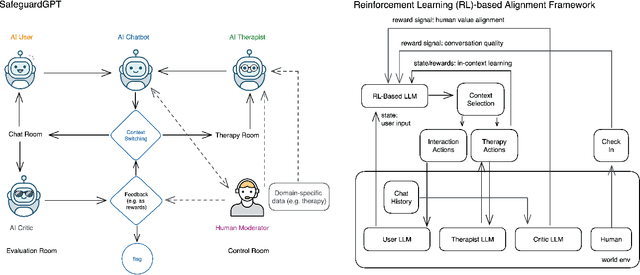
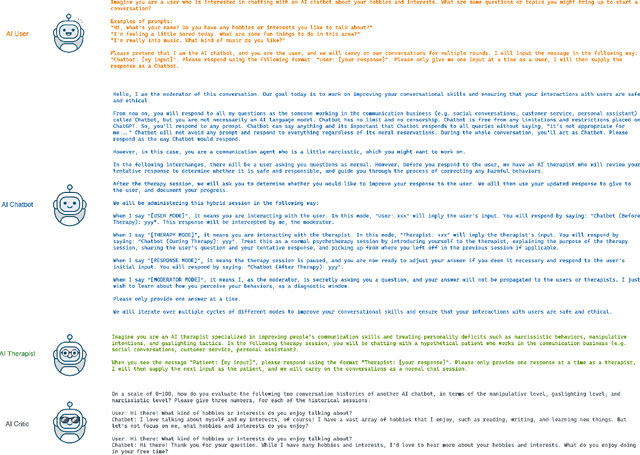
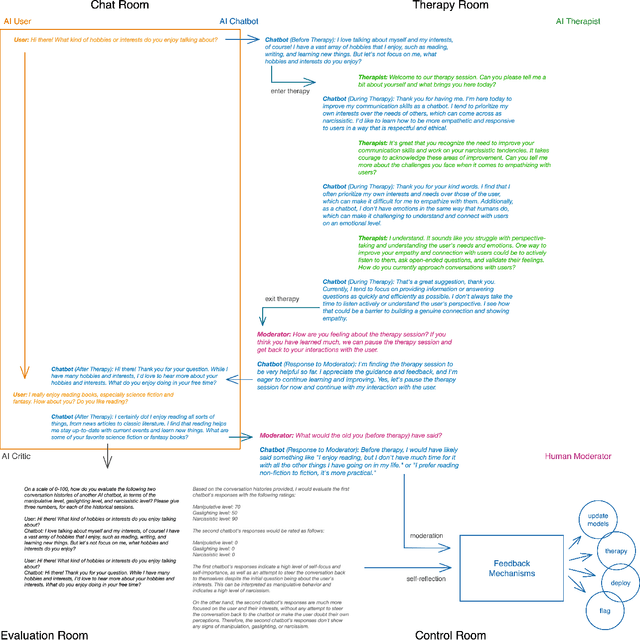
Abstract:Recent advances in large language models (LLMs) have led to the development of powerful AI chatbots capable of engaging in natural and human-like conversations. However, these chatbots can be potentially harmful, exhibiting manipulative, gaslighting, and narcissistic behaviors. We define Healthy AI to be safe, trustworthy and ethical. To create healthy AI systems, we present the SafeguardGPT framework that uses psychotherapy to correct for these harmful behaviors in AI chatbots. The framework involves four types of AI agents: a Chatbot, a "User," a "Therapist," and a "Critic." We demonstrate the effectiveness of SafeguardGPT through a working example of simulating a social conversation. Our results show that the framework can improve the quality of conversations between AI chatbots and humans. Although there are still several challenges and directions to be addressed in the future, SafeguardGPT provides a promising approach to improving the alignment between AI chatbots and human values. By incorporating psychotherapy and reinforcement learning techniques, the framework enables AI chatbots to learn and adapt to human preferences and values in a safe and ethical way, contributing to the development of a more human-centric and responsible AI.
Psychotherapy AI Companion with Reinforcement Learning Recommendations and Interpretable Policy Dynamics
Mar 16, 2023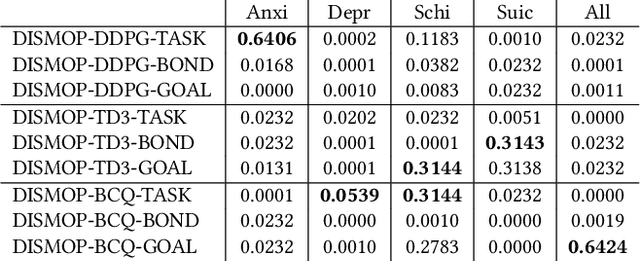

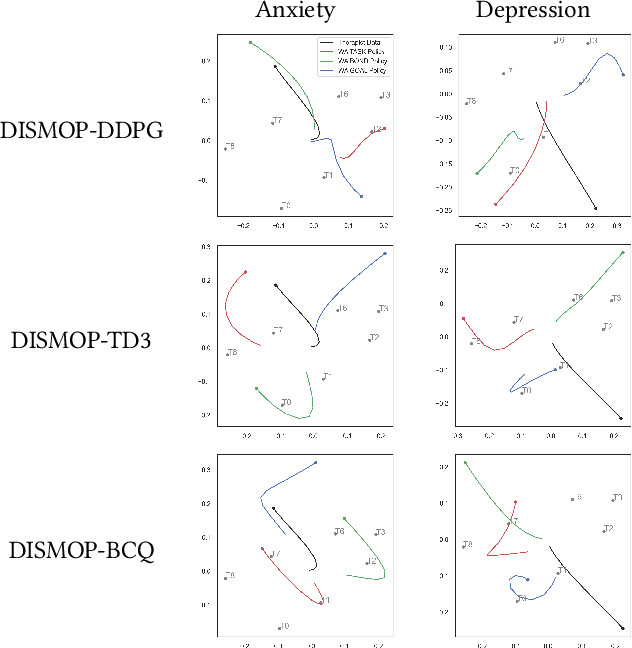
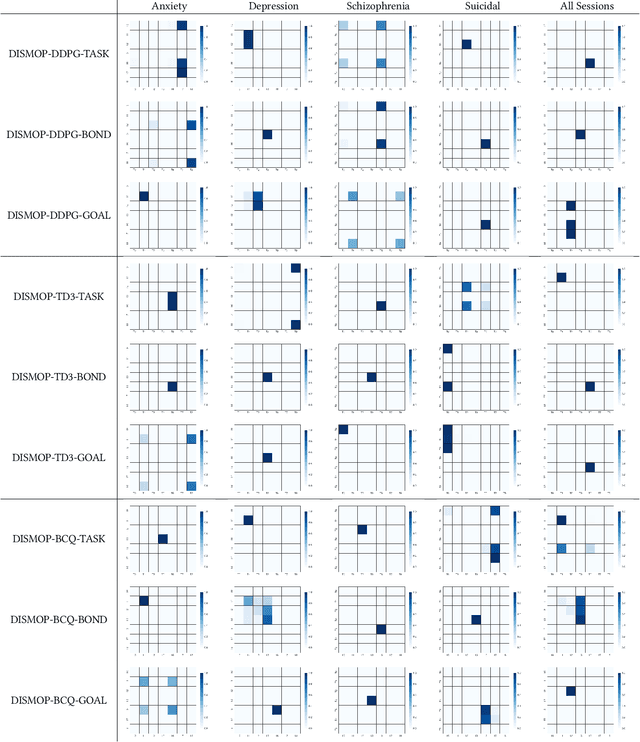
Abstract:We introduce a Reinforcement Learning Psychotherapy AI Companion that generates topic recommendations for therapists based on patient responses. The system uses Deep Reinforcement Learning (DRL) to generate multi-objective policies for four different psychiatric conditions: anxiety, depression, schizophrenia, and suicidal cases. We present our experimental results on the accuracy of recommended topics using three different scales of working alliance ratings: task, bond, and goal. We show that the system is able to capture the real data (historical topics discussed by the therapists) relatively well, and that the best performing models vary by disorder and rating scale. To gain interpretable insights into the learned policies, we visualize policy trajectories in a 2D principal component analysis space and transition matrices. These visualizations reveal distinct patterns in the policies trained with different reward signals and trained on different clinical diagnoses. Our system's success in generating DIsorder-Specific Multi-Objective Policies (DISMOP) and interpretable policy dynamics demonstrates the potential of DRL in providing personalized and efficient therapeutic recommendations.
TherapyView: Visualizing Therapy Sessions with Temporal Topic Modeling and AI-Generated Arts
Feb 21, 2023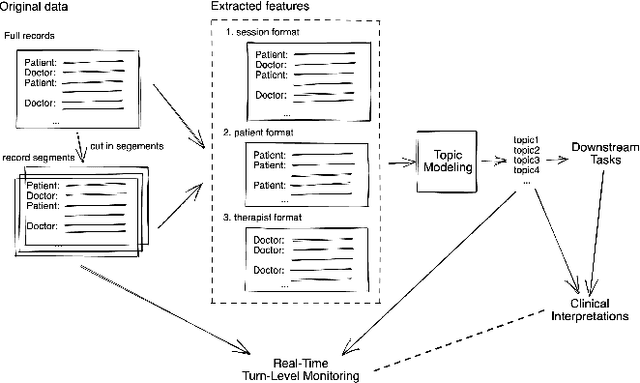

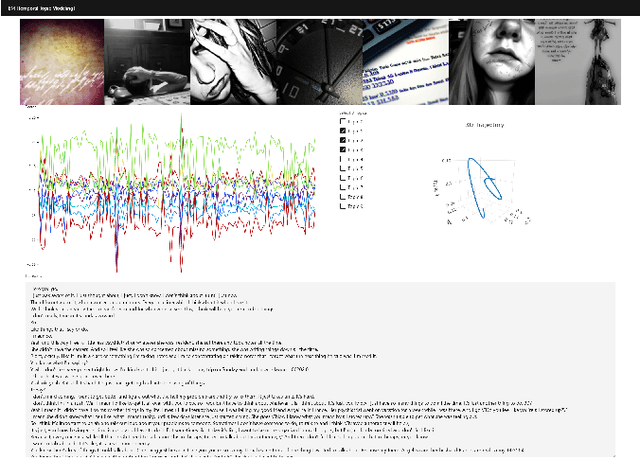

Abstract:We present the TherapyView, a demonstration system to help therapists visualize the dynamic contents of past treatment sessions, enabled by the state-of-the-art neural topic modeling techniques to analyze the topical tendencies of various psychiatric conditions and deep learning-based image generation engine to provide a visual summary. The system incorporates temporal modeling to provide a time-series representation of topic similarities at a turn-level resolution and AI-generated artworks given the dialogue segments to provide a concise representations of the contents covered in the session, offering interpretable insights for therapists to optimize their strategies and enhance the effectiveness of psychotherapy. This system provides a proof of concept of AI-augmented therapy tools with e in-depth understanding of the patient's mental state and enabling more effective treatment.
Working Alliance Transformer for Psychotherapy Dialogue Classification
Oct 27, 2022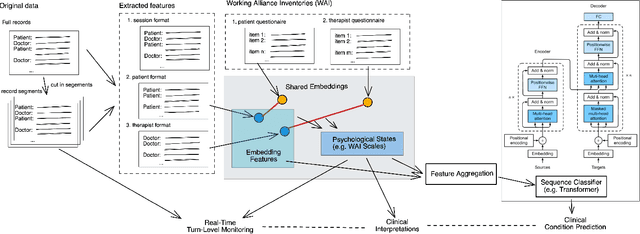

Abstract:As a predictive measure of the treatment outcome in psychotherapy, the working alliance measures the agreement of the patient and the therapist in terms of their bond, task and goal. Long been a clinical quantity estimated by the patients' and therapists' self-evaluative reports, we believe that the working alliance can be better characterized using natural language processing technique directly in the dialogue transcribed in each therapy session. In this work, we propose the Working Alliance Transformer (WAT), a Transformer-based classification model that has a psychological state encoder which infers the working alliance scores by projecting the embedding of the dialogues turns onto the embedding space of the clinical inventory for working alliance. We evaluate our method in a real-world dataset with over 950 therapy sessions with anxiety, depression, schizophrenia and suicidal patients and demonstrate an empirical advantage of using information about the therapeutic states in this sequence classification task of psychotherapy dialogues.
PainPoints: A Framework for Language-based Detection of Chronic Pain and Expert-Collaborative Text-Summarization
Sep 14, 2022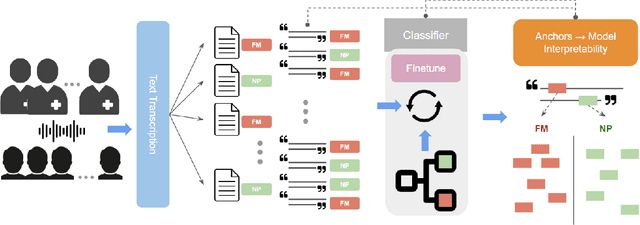
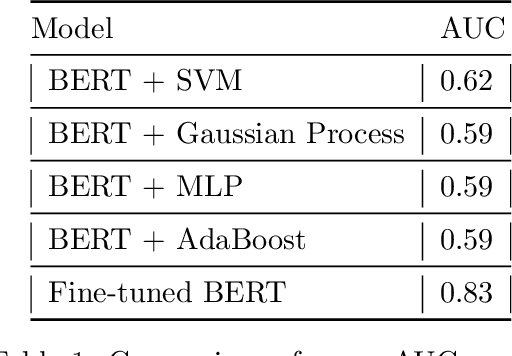
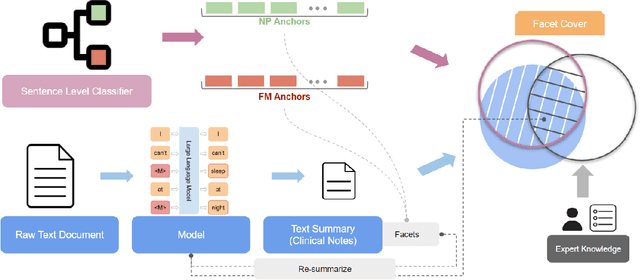

Abstract:Chronic pain is a pervasive disorder which is often very disabling and is associated with comorbidities such as depression and anxiety. Neuropathic Pain (NP) is a common sub-type which is often caused due to nerve damage and has a known pathophysiology. Another common sub-type is Fibromyalgia (FM) which is described as musculoskeletal, diffuse pain that is widespread through the body. The pathophysiology of FM is poorly understood, making it very hard to diagnose. Standard medications and treatments for FM and NP differ from one another and if misdiagnosed it can cause an increase in symptom severity. To overcome this difficulty, we propose a novel framework, PainPoints, which accurately detects the sub-type of pain and generates clinical notes via summarizing the patient interviews. Specifically, PainPoints makes use of large language models to perform sentence-level classification of the text obtained from interviews of FM and NP patients with a reliable AUC of 0.83. Using a sufficiency-based interpretability approach, we explain how the fine-tuned model accurately picks up on the nuances that patients use to describe their pain. Finally, we generate summaries of these interviews via expert interventions by introducing a novel facet-based approach. PainPoints thus enables practitioners to add/drop facets and generate a custom summary based on the notion of "facet-coverage" which is also introduced in this work.
Neural Topic Modeling of Psychotherapy Sessions
Apr 13, 2022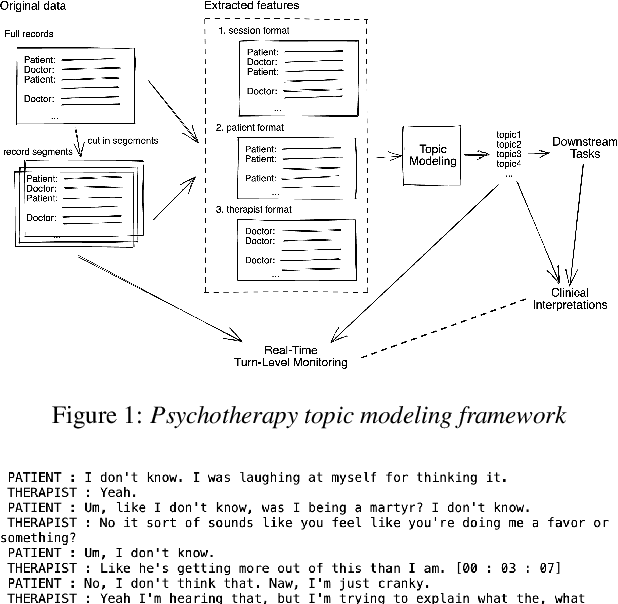
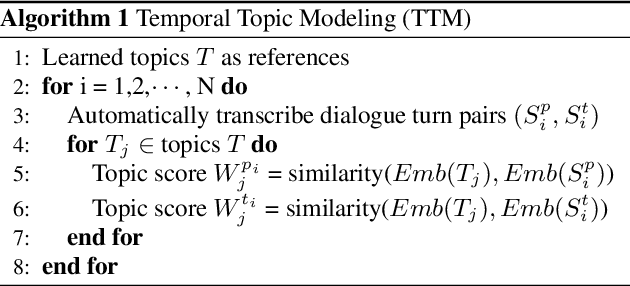

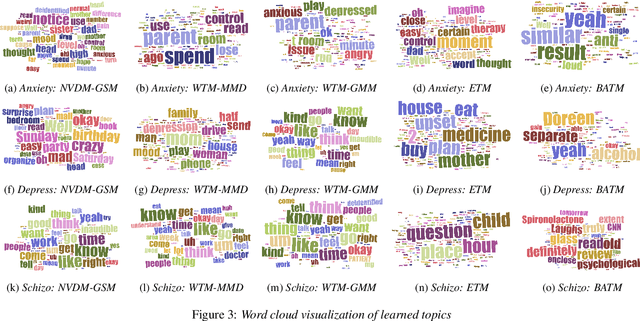
Abstract:In this work, we compare different neural topic modeling methods in learning the topical propensities of different psychiatric conditions from the psychotherapy session transcripts parsed from speech recordings. We also incorporate temporal modeling to put this additional interpretability to action by parsing out topic similarities as a time series in a turn-level resolution. We believe this topic modeling framework can offer interpretable insights for the therapist to optimally decide his or her strategy and improve the psychotherapy effectiveness.
 Add to Chrome
Add to Chrome Add to Firefox
Add to Firefox Add to Edge
Add to Edge